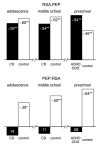Polyvagal Theory and developmental psychopathology: emotion dysregulation and conduct problems from preschool to adolescence
- PMID: 17045726
- PMCID: PMC1801075
- DOI: 10.1016/j.biopsycho.2005.08.008
Polyvagal Theory and developmental psychopathology: emotion dysregulation and conduct problems from preschool to adolescence
Abstract
In science, theories lend coherence to vast amounts of descriptive information. However, current diagnostic approaches in psychopathology are primarily atheoretical, emphasizing description over etiological mechanisms. We describe the importance of Polyvagal Theory toward understanding the etiology of emotion dysregulation, a hallmark of psychopathology. When combined with theories of social reinforcement and motivation, Polyvagal Theory specifies etiological mechanisms through which distinct patterns of psychopathology emerge. In this paper, we summarize three studies evaluating autonomic nervous system functioning in children with conduct problems, ages 4-18. At all age ranges, these children exhibit attenuated sympathetic nervous system responses to reward, suggesting deficiencies in approach motivation. By middle school, this reward insensitivity is met with inadequate vagal modulation of cardiac output, suggesting additional deficiencies in emotion regulation. We propose a biosocial developmental model of conduct problems in which inherited impulsivity is amplified through social reinforcement of emotional lability. Implications for early intervention are discussed.
Figures


References
-
- Achenbach TM. Manual for the child behavior checklist/4-18 and 1991 profile. University of Vermont Department of Psychiatry; Burlington, VT: 1991.
-
- American Psychiatric Association . Diagnostic and Statistical Manual of Mental Disorders. Author; Washington, DC: 1952.
-
- American Psychiatric Association . Diagnostic and Statistical Manual of Mental Disorders. 4th ed. Author; Washington, DC: 1994.
-
- American Psychiatric Association . Diagnostic and Statistical Manual of Mental Disorders. 4th ed. Author; Washington, DC: 2000. text revision.
-
- Beauchaine TP. Vagal tone, development, and Gray’s motivational theory: Toward an integrated model of autonomic nervous system functioning in psychopathology. Development and Psychopathology. 2001;13:183–214. - PubMed
Publication types
MeSH terms
Grants and funding
LinkOut - more resources
Full Text Sources
Medical
Miscellaneous

